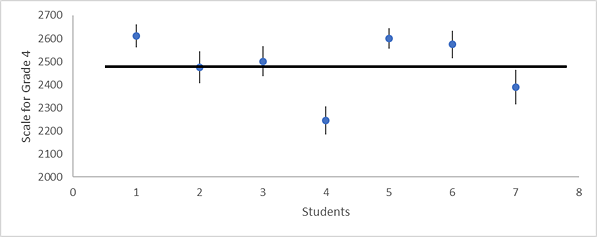Interim Assessment Blocks
Student results for Smarter Balanced Interim Assessment Blocks (IABs) and Focused Interim Assessment Blocks (FIABs) for ELA and mathematics are reported as one of three reporting categories which represents a range of scale scores: Above Standard, Near Standard, or Below Standard. For group-level reporting, a student score distribution by reporting category is also provided, which indicates the proportion of students that performed within each reporting category.
IAB/FIAB reporting categories—Above Standard, Near Standard, and Below Standard—differ from achievement levels (Level 4 [Exceeded the standard]; Level 3 [Met the standard]; Level 2 [Nearly met the standard]; Level 1 [Did not meet the standard]), which are used to communicate overall performance on the Smarter Balanced Interim Comprehensive Assessments (ICAs) and Smarter Balanced Summative Assessments for ELA and Mathematics.
A direct comparison cannot be made between IAB/FIAB reporting categories and achievement levels on the ICAs and summative assessments because IAB/FIAB reporting categories are derived differently than the ICA and summative achievement levels. ICA and summative achievement levels represent a range of scale scores and are explained in more detail in the section: Summative Assessments and Interim Comprehensive Assessments.
NOTE: Student scores on California Science Test (CAST) Interim Assessments are reported with achievement levels and student scores on the ELPAC Interim Assessments are reported with performance levels, both of which are different from IAB/FIAB reporting categories. Please note that overall performance on the CAST and ELPAC interim assessments is explained in more detail in the sections: Reporting Overall Performance on CAST Interim Assessments and Reporting Overall Performance on ELPAC Interim Assessments.
IAB/FIAB reporting categories are calculated using the grade-level performance standard, which is defined as the summative (and ICA) cut score between Levels 2 and 3 for each tested grade. Student performance on an IAB/FIAB is evaluated against the grade-level performance standard (e.g., a student’s scale score for the Grade 3 Numbers and Operations—Fractions IAB is compared to the Grade 3 mathematics summative assessment performance standard). To access these grade-level scores, refer to Tables 1 and 2: Smarter Balanced Summative and ICA Scale Score Ranges by Content and Grade. A calculation using the grade-level performance standard and the student’s standard error of measurement (SEM) determines the range for the middle IAB/FIAB reporting category, Near Standard.
The SEM represents the range in which a student’s score is likely to be if that student were to take the test multiple times, or if the student were to take a test of parallel construction and similar difficulty, without receiving further instruction. In other words, the SEM represents the uncertainty around a student’s scale score. The SEM is multiplied by 1.5 to create a confidence interval that likely includes the student’s true score. The confidence interval is even larger than the student’s SEM, so it provides greater certainty, or confidence, in the reporting category classification. IAB/FIAB scale scores are derived using fewer items than the overall vertical scale scores on the ICAs and summative assessments. Therefore, the standard error of measurement for an IAB or FIAB scale score will be greater than that of the overall vertical scale score of the ICAs or summative assessments.
Figure 1 contains a dot representing the scale score for each of seven students being evaluated on a Grade 4 Math IAB. The bars above and below the scale score are the confidence interval, or 1.5 times the SEM on the test. The dark horizontal line is the performance standard for the summative and ICA Grade 4 Math assessments—a scale score of 2485. If the confidence interval for the student’s scale score on the IAB is completely above the performance standard, as in Students 1, 5, and 6, the student’s reporting category is Above Standard. If the confidence interval for the student’s scale score is completely below the performance standard, as in Students 4 and 7, the student’s reporting category is Below Standard. If the confidence interval for the student’s scale score touches the performance standard, as in Students 2 and 3, the student’s reporting category is Near Standard, regardless of whether the reported scale score is above or below the performance standard.

Figure 1. Examples of Student Confidence Intervals and the Performance Standard for a Grade 4 Math IAB.
Please note that the scale score of some students in the Near Standard category will be either above or below the performance standard, but not far enough above or below, such that the performance can be confidently labeled as Above Standard or Below Standard.
For full technical details on the calculations used, please refer to Chapter 8 of the Smarter Balanced Scoring Specifications.

